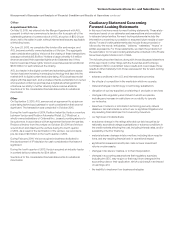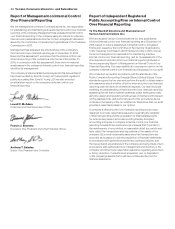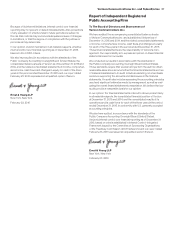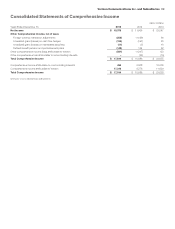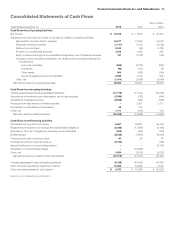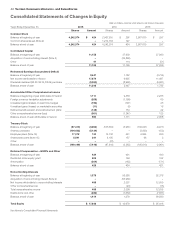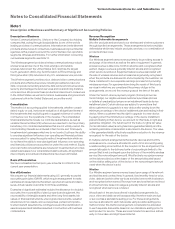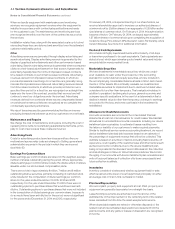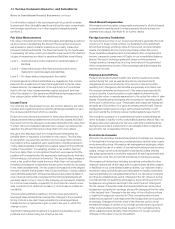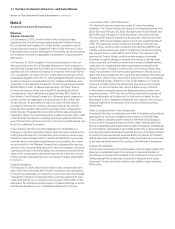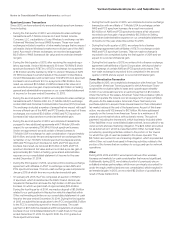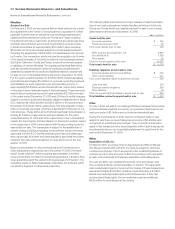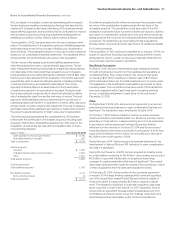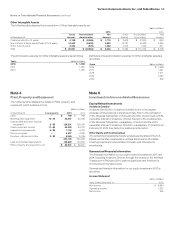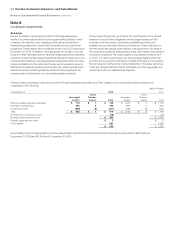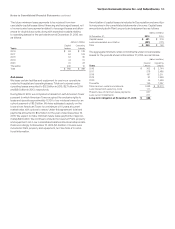America Online 2015 Annual Report Download - page 47
Download and view the complete annual report
Please find page 47 of the 2015 America Online annual report below. You can navigate through the pages in the report by either clicking on the pages listed below, or by using the keyword search tool below to find specific information within the annual report.We capitalize and depreciate network software purchased
or developed along with related plant assets. We also capi-
talize interest associated with the acquisition or construction of
network- related assets. Capitalized interest is reported as a reduction
in interest expense and depreciated as part of the cost of the
network- related assets.
In connection with our ongoing review of the estimated remaining
average useful lives of plant, property and equipment, we determined
that changes were necessary to the remaining estimated useful lives
of certain assets as a result of technology upgrades, enhancements,
and planned retirements. These changes resulted in an increase in
depreciation expense of $0.4billion and $0.6billion in 2015 and 2014,
respectively. While the timing and extent of current deployment plans
are subject to ongoing analysis and modification, we believe the
current estimates of useful lives are reasonable.
Computer Software Costs
We capitalize the cost of internal-use network and non- network
software that has a useful life in excess of one year. Subsequent
additions, modifications or upgrades to internal-use network and
non- network software are capitalized only to the extent that they allow
the software to perform a task it previously did not perform. Planning,
software maintenance and training costs are expensed in the period
in which they are incurred. Also, we capitalize interest associated with
the development of internal-use network and non- network software.
Capitalized non- network internal-use software costs are amortized
using the straight-line method over a period of 3 to 8 years and are
included in Other intangible assets, net in our consolidated balance
sheets. For a discussion of our impairment policy for capitalized
software costs, see “Goodwill and Other Intangible Assets” below.
Also, see Note3 for additional detail of internal-use non- network
software reflected in our consolidated balance sheets.
Goodwill and Other Intangible Assets
Goodwill
Goodwill is the excess of the acquisition cost of businesses over the
fair value of the identifiable net assets acquired. Impairment testing
for goodwill is performed annually in the fourth fiscal quarter or
more frequently if impairment indicators are present. To determine if
goodwill is potentially impaired, we have the option to perform a qual-
itative assessment. However, we may elect to bypass the qualitative
assessment and perform an impairment test even if no indications of
a potential impairment exist. The impairment test for goodwill uses a
two-step approach, which is performed at the reporting unit level. Step
one, performed to identify potential impairment, compares the fair
value of the reporting unit (calculated using a market approach and/
or a discounted cash flow method) to its carrying value. If the carrying
value exceeds the fair value, there is a potential impairment and step
two must be performed to measure the amount of the impairment
charge. Step two compares the carrying value of the reporting unit’s
goodwill to its implied fair value (i.e., fair value of reporting unit less
the fair value of the unit’s assets and liabilities, including identifiable
intangible assets). If the implied fair value of goodwill is less than the
carrying amount of goodwill, an impairment charge is recognized.
Intangible Assets Not Subject to Amortization
A significant portion of our intangible assets are wireless licenses that
provide our wireless operations with the exclusive right to utilize des-
ignated radio frequency spectrum to provide wireless communication
services. While licenses are issued for only a fixed time, generally
ten years, such licenses are subject to renewal by the Federal
Communications Commission (FCC). License renewals have occurred
routinely and at nominal cost. Moreover, we have determined that there
are currently no legal, regulatory, contractual, competitive, economic
or other factors that limit the useful life of our wireless licenses. As a
result, we treat the wireless licenses as an indefinite-lived intangible
asset. We reevaluate the useful life determination for wireless licenses
each year to determine whether events and circumstances continue to
support an indefinite useful life.
We test our wireless licenses for potential impairment annually or
more frequently if impairment indicators are present. We have the
option to first perform a qualitative assessment to determine whether
it is necessary to perform a quantitative impairment test. However,
we may elect to bypass the qualitative assessment in any period
and proceed directly to performing the quantitative impairment test.
The most recent quantitative assessment of our wireless licenses
occurred in 2015. Our quantitative assessment consisted of comparing
the estimated fair value of our aggregate wireless licenses to the
aggregated carrying amount as of the test date. Using a quantitative
assessment, we estimated the fair value of our aggregate wireless
licenses using the Greenfield approach. The Greenfield approach is
an income based valuation approach that values the wireless licenses
by calculating the cash flow generating potential of a hypothetical
start-up company that goes into business with no assets except the
wireless licenses to be valued. A discounted cash flow analysis is
used to estimate what a marketplace participant would be willing to
pay to purchase the aggregated wireless licenses as of the valuation
date. If the estimated fair value of the aggregated wireless licenses
is less than the aggregated carrying amount of the wireless licenses
then an impairment charge is recognized. In 2014 and 2013, we
performed a qualitative assessment to determine whether it is more
likely than not that the fair value of our wireless licenses was less
than the carrying amount. As part of our assessment, we considered
several qualitative factors including the business enterprise value of
our Wireless segment, macroeconomic conditions (including changes
in interest rates and discount rates), industry and market consid-
erations (including industry revenue and EBITDA (Earnings before
interest, taxes, depreciation and amortization) margin projections), the
projected financial performance of our Wireless segment, as well as
other factors.
Interest expense incurred while qualifying activities are performed to
ready wireless licenses for their intended use is capitalized as part of
wireless licenses. The capitalization period ends when the develop-
ment is discontinued or substantially complete and the license is ready
for its intended use.
Intangible Assets Subject to Amortization and Long-LivedAssets
Our intangible assets that do not have indefinite lives (primarily
customer lists and non- network internal-use software) are amortized
over their estimated useful lives. All of our intangible assets subject
to amortization and long-lived assets are reviewed for impairment
whenever events or changes in circumstances indicate that the
carrying amount of the asset may not be recoverable. If any indica-
tions were present, we would test for recoverability by comparing the
carrying amount of the asset group to the net undiscounted cash flows
expected to be generated from the asset group. If those net undis-
counted cash flows do not exceed the carrying amount, we would
perform the next step, which is to determine the fair value of the asset
and record an impairment, if any. We reevaluate the useful life deter-
minations for these intangible assets each year to determine whether
events and circumstances warrant a revision to their remaining
useful lives.
45Verizon Communications Inc. and Subsidiaries
Notes to Consolidated Financial Statements continued


